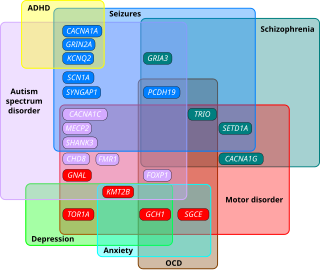
Casein is a family of related phosphoproteins that are commonly found in mammalian milk, comprising about 80% of the proteins in cow's milk and between 20% and 60% of the proteins in human milk. Sheep and cow milk have a higher casein content than other types of milk with human milk having a particularly low casein content.

A gluten-free diet (GFD) is a nutritional plan that strictly excludes gluten, which is a mixture of prolamin proteins found in wheat, as well as barley, rye, and oats. The inclusion of oats in a gluten-free diet remains controversial, and may depend on the oat cultivar and the frequent cross-contamination with other gluten-containing cereals.

Autism spectrum disorders (ASD) are neurodevelopmental disorders that begin in early childhood, persist throughout adulthood, and affect three crucial areas of development: communication, social interaction and restricted patterns of behavior. There are many conditions comorbid to autism spectrum disorders such as attention-deficit hyperactivity disorder and epilepsy.

Casomorphin is an opioid peptide derived from the digestion of the milk protein casein.
Ole Ivar Løvaas was a Norwegian-American clinical psychologist and professor at the University of California, Los Angeles. He is most well known for his research on what is now called applied behavior analysis (ABA) to teach autistic children through prompts, modeling, and positive reinforcement. The therapy is also noted for its use of aversives (punishment) to reduce undesired behavior, however these are now used less commonly than in the past.
Son-Rise is a home-based program for children and adults with autism spectrum disorders and other developmental disabilities, which was developed by Barry Neil Kaufman and Samahria Lyte Kaufman for their son Raun, who was diagnosed with autism and is claimed to have fully recovered from his condition. The program is described by Autism Speaks as a "child-centered program that places parents as the key therapists and directors of their program."
Gluten exorphins are a group of opioid peptides formed during the digestion of the gluten protein. These peptides work as external regulators for gastrointestinal movement and hormonal release. The breakdown of gliadin, a polymer of wheat proteins, creates amino acids that stop the gluten epitopes from entering the immune system to activate inflammatory reactions. During this process, gluten does not fully break down, thus increasing the presence of gluten exorphins. Because of this, researchers think this is what might lead to various diseases.

Gliadorphin is an opioid peptide that is formed during digestion of the gliadin component of the gluten protein. It is usually broken down into amino acids by digestion enzymes. It has been hypothesized that children with autism have abnormal leakage from the gut of this compound. This is partly the basis for the gluten-free, casein-free diet. Abnormally high levels of gliadorphin have been found in the urine of autistic children via mass spectrometry testing.
The following outline is provided as an overview of and topical guide to autism:

The causes of autism are environmental or genetic factors that predispose an individual to develop autism, also known as autism spectrum disorder (ASD). Many causes of autism have been proposed, but understanding of the theory of causation of autism is incomplete. Attempts have been made to incorporate the known genetic and environmental causes into a comprehensive causative framework. ASD is a neurodevelopmental disorder marked by impairments in communicative ability and social interaction and restricted/repetitive behaviors, interests, or activities not suitable for the individual's developmental stage. The severity of symptoms and functional impairment vary between individuals.

Autism therapies include a wide variety of therapies that help people with autism, or their families. Such methods of therapy seek to aid autistic people in dealing with difficulties and increase their functional independence.
The specific carbohydrate diet (SCD) is a restrictive diet originally created to manage celiac disease; it limits the use of complex carbohydrates. Monosaccharides are allowed, and various foods including fish, aged cheese and honey are included. Prohibited foods include cereal grains, potatoes and lactose-containing dairy products. It is a gluten-free diet since no grains are permitted.
Alternative therapies for developmental and learning disabilities include a range of practices used in the treatment of dyslexia, ADHD, autism spectrum disorders, Down syndrome and other developmental and learning disabilities. Treatments include changes in diet, dietary supplements, biofeedback, chelation therapy, homeopathy, massage and yoga. These therapies generally rely on theories that have little scientific basis, lacking well-controlled, large, randomized trials to demonstrate safety and efficacy; small trials that have reported beneficial effects can be generally explained by the ordinary waxing and waning of the underlying conditions.

Classic autism, also known as childhood autism, autistic disorder, (early) infantile autism, infantile psychosis, Kanner's autism,Kanner's syndrome, or (formerly) just autism, is a neurodevelopmental condition first described by Leo Kanner in 1943. It is characterized by atypical and impaired development in social interaction and communication as well as restricted, repetitive behaviors, activities, and interests. These symptoms first appear in early childhood and persist throughout life.

Autism, formally called autism spectrum disorder (ASD) or autism spectrum condition (ASC), is a neurodevelopmental disorder marked by deficits in reciprocal social communication and the presence of restricted and repetitive patterns of behavior. Other common signs include difficulty with social interaction, verbal and nonverbal communication, along with perseverative interests, stereotypic body movements, rigid routines, and hyper- or hyporeactivity to sensory input. Autism is clinically regarded as a spectrum disorder, meaning that it can manifest very differently in each person. For example, some are nonspeaking, while others have proficient spoken language. Because of this, there is wide variation in the support needs of people across the autism spectrum.
Exorphins are exogenous opioid peptides, distinguished from endorphins, or endogenous opioid peptides.
Paul Shattock is a British autism researcher and scientific consultant to the charity Education and Services for People with Autism, of which he is also the founder. He was formerly the director of the Autism Research Unit at the University of Sunderland. He is well known for his disputed research into dietary therapy and autism, having claimed that autistic children may have a "leaky gut" which allows certain peptides to enter the bloodstream, and claimed that they excrete unusually high levels thereof. As a result of this speculation, he has promoted the use of a gluten-free, casein-free diet to ameliorate the symptoms of autism, a theory he developed along with Kalle Reichelt. In addition, he has claimed that a protein found in milk may play a role in the etiology of autism. He is also the former president of the World Autism Organization.
The opioid excess theory is a theory which postulates that autism is the result of a metabolic disorder in which opioid peptides produced through metabolism of gluten and casein pass through an abnormally permeable intestinal membrane and then proceed to exert an effect on neurotransmission through binding with opioid receptors. It is believed by advocates of this hypothesis that autistic children are unusually sensitive to gluten, which results in small bowel inflammation in these children, which in turn allows these opioid peptides to enter the brain.
Timothy M. Buie is a pediatric gastroenterologist at Boston Children’s Hospital. Buie joined Harvard Medical School in 1998 after previously practicing at Pediatric Gastroenterology Associates for eight years. He was also the director of Gastrointestinal and Nutritional Services at MGH's Lurie Center for Autism. He is well known for his research pertaining to the possible connection between autism and gastrointestinal disorders, and has told the Interagency Autism Coordinating Committee that over half of autistic children experience gastrointestinal symptoms, whereas he stated that this was the case for "between 50 and 70%" of children with autism in an interview with ABC News. He has also said that a subset of autistic children may benefit from gluten-free, casein-free diets, and that more research is needed into this area. Buie was honored as "Professional of the Year" by the Autism Society of America in 2009.







